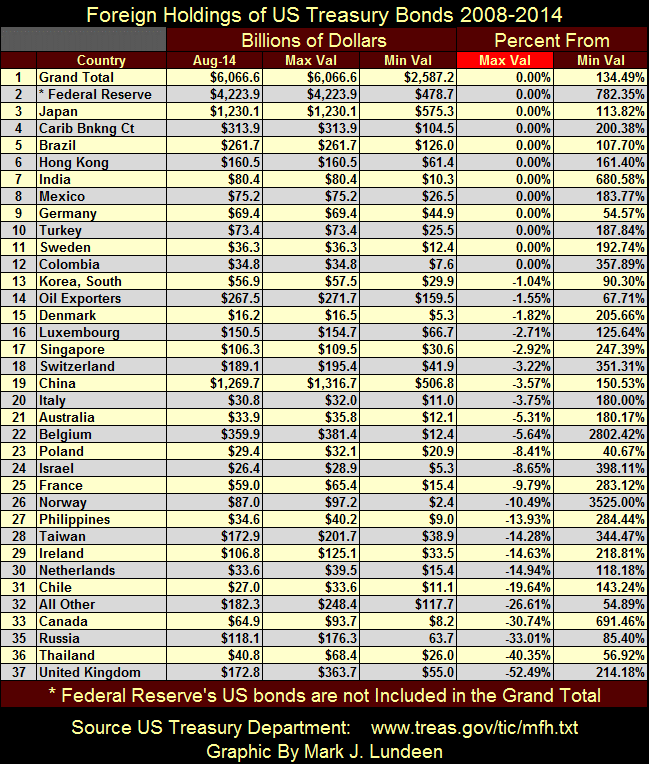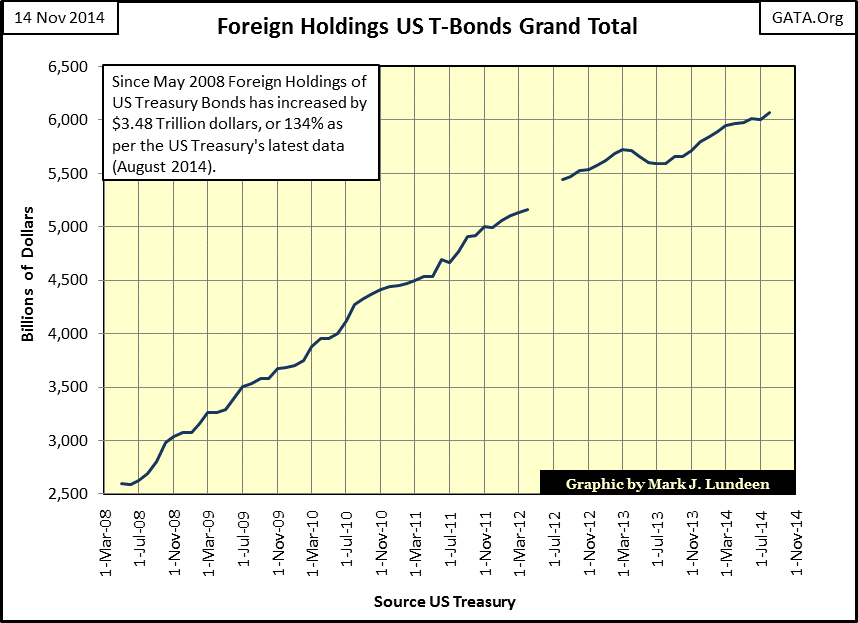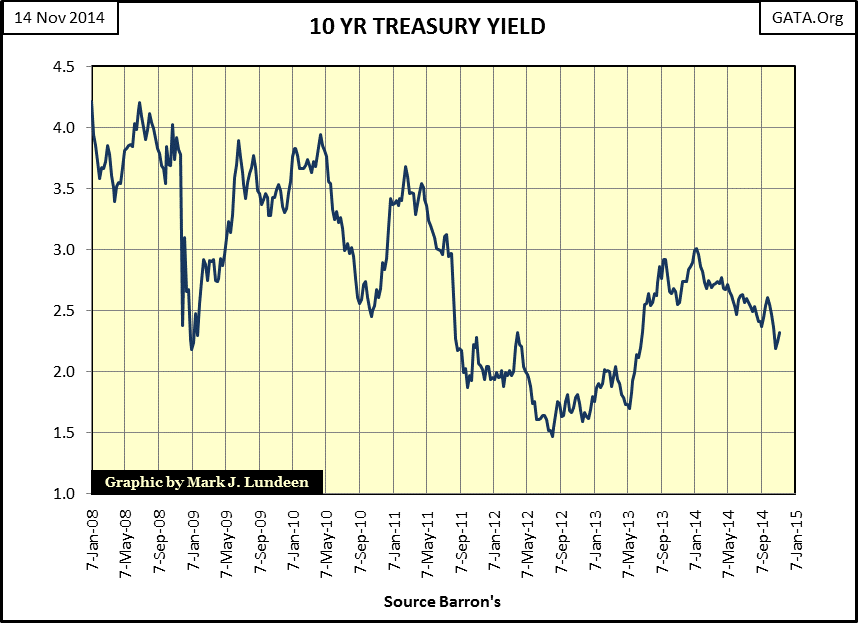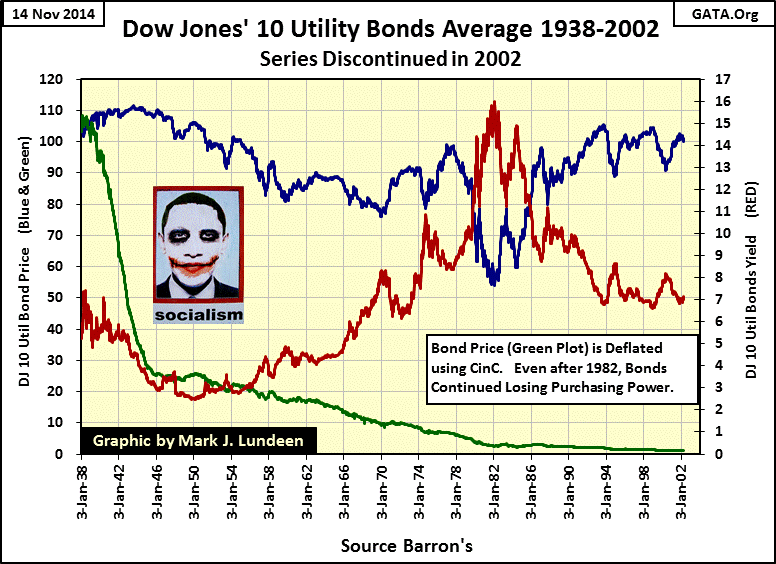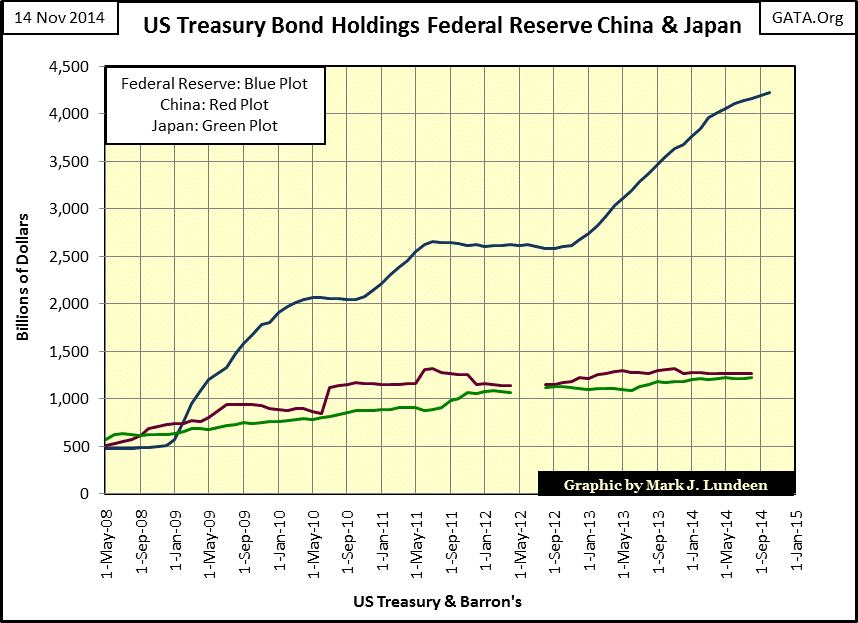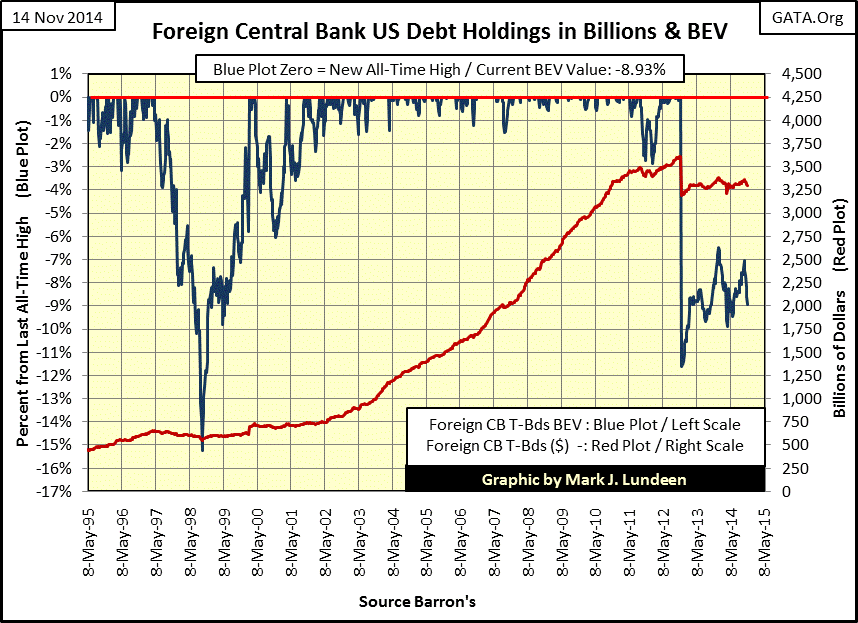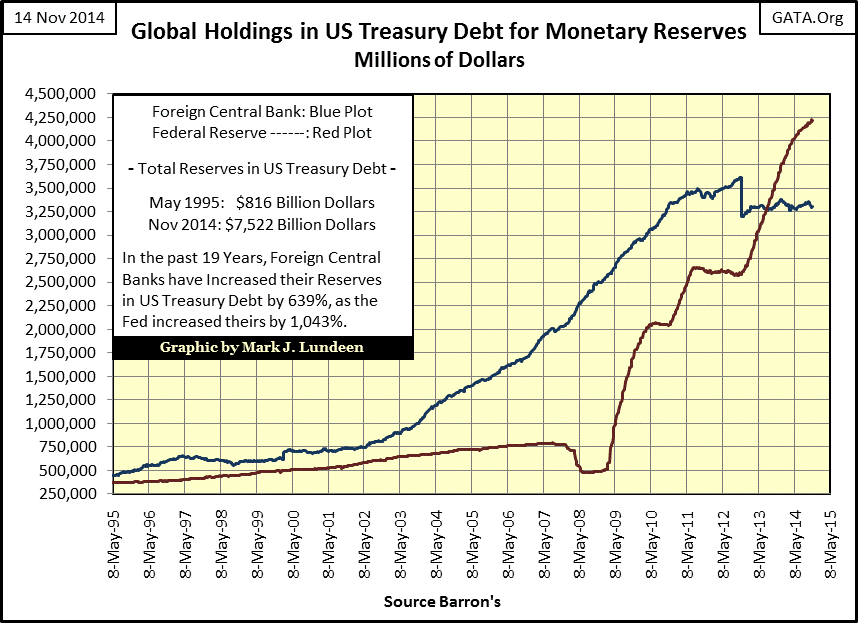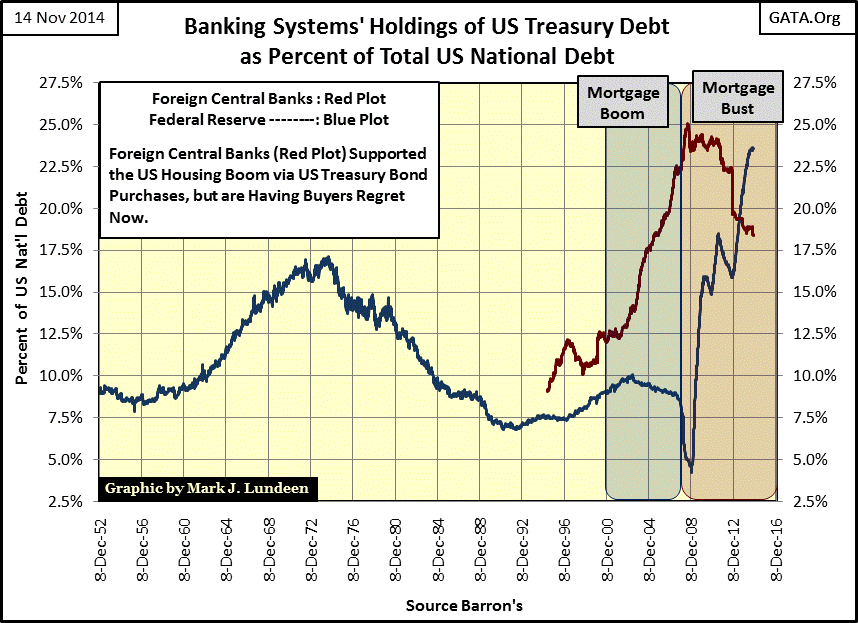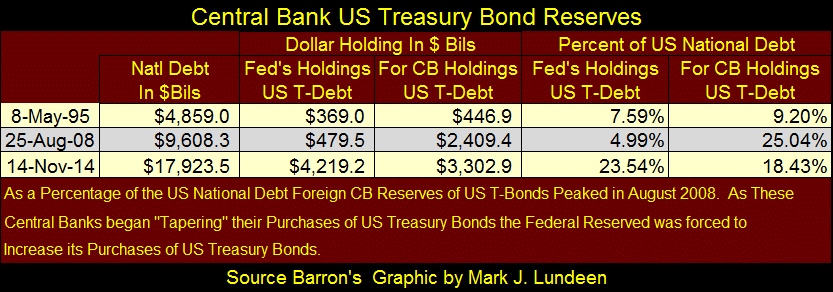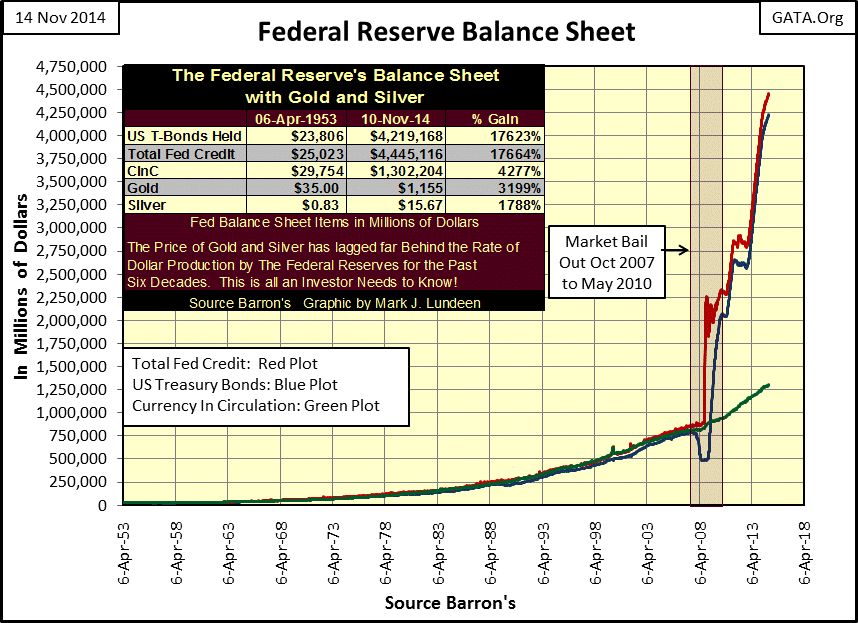Holders Of US Treasury Debt
Using data from the US Treasury, updated through August of this year, let’s take a look at who is purchasing US Treasury bonds:
http://www.treasury.gov/ticdata/Publish/mfh.txt
The countries in the table below don’t include all the countries listed in the US Treasury data; I only include those that have been continuously listed since May 2008. Countries not continuously listed excluded from the data, but these are small holdings with little overall impact of the table below.
The table is broken up as follows; under “Billions of Dollars” I’ve listed the most recent data (August 2014), as well as the maximum and minimum holdings since May 2008. The “Percent From” column shows the current percentage change from both the Maximum and Minimum holdings of the past six years. The table is sorted by Percent from Max Value (highlighted in bright red).
A 0.00% figure in the Max Val column signifies that the country’s holdings of US Treasury bonds is currently at a new all-time high; as we see below there are twelve countries whose holdings of US Treasury bonds made new all-time highs in August. The Min Val column indicates the percentage increase of the most recent data from the lowest holdings of US Treasury bonds since May 2008. The countries with the largest percentage increases were Norway (#26) and Belgium (#22). The Oil Exporters (#14) are interesting. Their major export, petroleum, is a huge market priced in dollars, but it seems that since May 2008 they’ve found investments other than US T-bonds to place the bulk of their profits. This of course assumes that these countries have realized more than $112 billion dollars in profit over the past six years, which I believe is a safe assumption.
Below we see a chart plotting the Grand Total from the table above, from May 2008 to present; please excuse the gap in data from May-July 2012. There is no denying it; the world is still willing to purchase Uncle Sam’s IOUs, but why is the question. Washington never really pays off its debts; the US Treasury is still rolling over debts from Roosevelt’s “New Deal” programs during the Great Depression, but neither taxpayers nor creditors like to think about that.
The chart below shows the yield for the 10 Year T-Note over the past seven years. In a world of zero inflation these notes would certainly be worth holding. However anyone shopping for groceries and paying monthly bills knows that the cost of living is rising faster than the CPI figure put out by the Bureau of Labor Statistics would have us believe. The actual increase in the cost of living is higher than the pre-tax yields one can receive in the Treasury market, (and much higher than the after tax yields).
This is due to multiple gimmicks such as “hedonics” and “substitution” that the BLS uses to make the announced inflation figure come in lower than actual price inflation. If they reported the raw data instead, we would see an inflation figure closer to 10%. And the government’s motivation for tweaking the data? To minimize the cost of living allowances for Social Security (and other government programs), and to camouflage the actual rate that the US dollar is depreciating against real goods.
This market anomaly won’t last forever. When the bond market’s perception of inflation risks comes more in line with reality, Treasury bond prices will plummet yields will skyrocket and the decline in purchasing power of the dollar will accelerate.
This is exactly what happened from the 1950s to 1981; inflation rates were consistently higher than the yields offered in the bond market (Red Plot below). It was a good deal for corporations and governments selling bonds, but a raw deal for bond purchasers. Finally in the 1970s the bond market entered a period of crisis. Falling prices and rising yields earned bonds the moniker “certificates of confiscation.” It was for this reason that the precious metals enjoyed a huge bull market during the 1970s, as rising interest rates drove wealth from the fixed income market into the safety of the old monetary metals. It will soon be happening again, and for the same reason: the volume of money circulating in the economy and financial markets is constantly being increased by the Federal Reserve and other central banks. This can only end badly.
Back to the table above, we see the two largest foreign holders of US Treasury bonds are China (#19) and Japan (#3). It’s interesting to note that back in May 2008 both China and Japan held more US Treasury bonds than the Federal Reserve. However all that changed in January 2009 when Doctor Bernanke began bailing out Wall Street from the mortgage debacle. His three Quantitative Easings can be seen below, ultimately making the Federal Reserve the world’s largest single holder of US Treasury bonds in the world, which doesn’t exactly bolster confidence in the US dollar. It makes one wonder what would have happened to the economy if the Fed had only increased their US Treasury bond holdings by 150% like Japan and China did over this period instead of by 750%.
The US T-debt data above is from the US Treasury, but the Federal Reserve also publishes data on the US Treasury debt held by foreign-central banks. In the chart below we see this Fed data in two formats; the blue plot (Left Scale) displays the data in Bear’s Eye View (BEV) format; the red plot (Right Scale) is in billions of dollars.
The big 15% decline seen in the BEV plot from 1997-98 occurred during the “Asian Contagion.” Hot money from hedge funds (courtesy of the Federal Reserve System) flowed into South-East Asia in the mid-1990s resulting in double-digit bull market gains. A few years later this money left SE Asia even faster as the bulls sold to lock in their gains. Asian national governments and central banks sold their holdings of US T-bonds to “stabilize” their markets, resulting in the 15% decline seen in the BEV plot below. This crisis was big news at the time (though little remembered today), unlike the 11.5% decline seen in 2012 that produced no media coverage at all.
What happened in 2012? I haven’t a clue, but the sudden reduction in foreign holdings of US T-debt wasn’t caused by any specific crisis – (although I’m sure it was a hot topic at the Federal Reserve at the time). If I were to guess, I would say that some central bank (or banks) was making a point that enough was enough when it came to supporting the continually increasing debt of the US government.
Foreign-central banks’ enthusiasm for US Treasury debt has abated since May 2011, but as seen below (Blue Plot) they were huge buyers of Uncle Sam’s IOUs during the mortgage boom, and continued purchasing T-debt for a few years into the bust.
Below we see the data above as a percentage of US national debt, and I also plotted the Federal Reserve’s Treasury debt holdings as a percentage of national debt going back to 1952. The chart displays six decades of monetary history you’ll see nowhere else. This chart makes it clear that the mortgage crisis has been, and continues to be the largest monetary crisis since World War Two. One can also infer from the chart that since 2008 foreign-central banks are no longer willing “to go along, to get along” with US “policy makers.”
The following table lists the data 1) when Barron’s first published the Treasury bond holdings of foreign central banks, 2) when these foreign central banks held their largest percentage of the US national debt, and 3) the data from last week’s issue of Barron’s. This table makes the point that since the 11% decline in foreign central bank holdings of US Treasury bonds in November 2012 (three charts up), these CBs haven’t really been buying additional T-bonds, or selling their current holdings, so their percentage ownership of the US national debt is declining because Washington continues to go deeper into debt.
A quick review of the three charts and table above using the Federal Reserve data on foreign central banks, shows that the global central banking system is no longer an eager participant in the inflationary monetary policy dictated by the Federal Reserve.
The reason is not difficult to comprehend; during the 1980s and 1990s inflating the global money supply produced financial asset bubbles that everyone believed to be bull markets. But today the global monetary system has reached the point where inflating the money supply produces more pain than gain. But the damage to asset prices done by four decades of monetary inflation, and the increased debt burden on individuals, corporations and governments will eventually overwhelm their income. There is certainly no painless solution out of the inflationary problem we now all face as counter-party risk has run amuck while government regulators watched and did nothing. One need only look at the Federal Reserve’s balance sheet to see that lunatics have been running the asylum for a very long time. Decades from now economic historians will look at this data and ask themselves “what the heck were they thinking!?”
Like you, I’m sick of hearing about pending increases in the price for gold and silver. But we must keep in mind that the day is rapidly approaching when debt will become more than just another dirty four letter word. Everyone should protect themselves by selling a good portion of their stock portfolio at today’s subsidized high prices, and purchasing some gold and especially silver (bullion only, and take possession, no ETF’s, or other derivatives) at today’s subsidized low prices.






